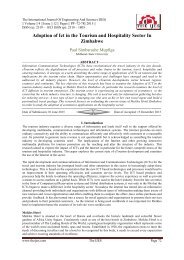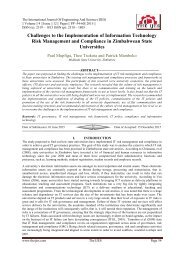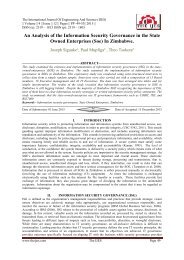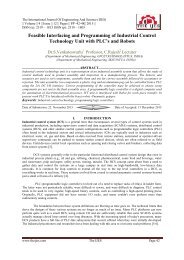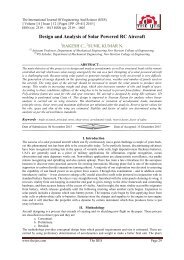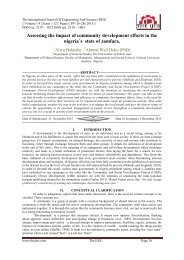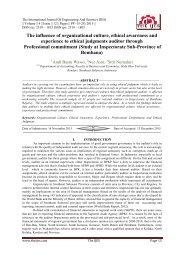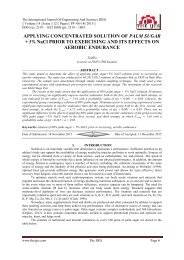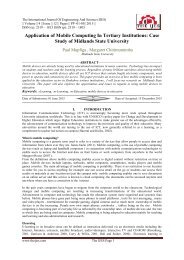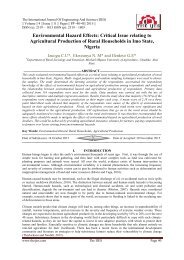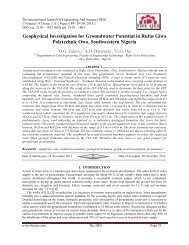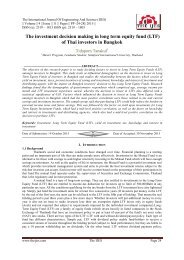Antimicrobial Studies of Phyllanthus maderaspatensis And Celosia argentea
The International Journal of Engineering
The International Journal of Engineering
You also want an ePaper? Increase the reach of your titles
YUMPU automatically turns print PDFs into web optimized ePapers that Google loves.
The International Journal Of Engineering <strong>And</strong> Science (IJES)<br />
|| Volume || 3 || Issue || 3 || Pages || 35-38 || 2014 ||<br />
ISSN (e): 2319 – 1813 ISSN (p): 2319 – 1805<br />
<strong>Antimicrobial</strong> <strong>Studies</strong> <strong>of</strong> <strong>Phyllanthus</strong> <strong>maderaspatensis</strong><br />
<strong>And</strong> <strong>Celosia</strong> <strong>argentea</strong><br />
S. Swarupa Rani 1 , R.R.Venkata Raju 2<br />
1 The Adoni Arts & Science College, Adoni,India.<br />
2 Department <strong>of</strong> Botany,Sri Krishnadevaraya University,Ananthapur,India.<br />
--------------------------------------------------------ABSTRACT--------------------------------------------------<br />
<strong>Phyllanthus</strong> <strong>maderaspatensis</strong>, a dominant weed in Jowar fields and <strong>Celosia</strong> <strong>argentea</strong>, a dominant weed in<br />
Redgram fields were identified by the IVI studies conducted in the test fields <strong>of</strong> Kurnool district, <strong>And</strong>hra<br />
Pradesh. Though they are weed plants they have medicinal value. Their Allelopathic influence was noted down<br />
by petriplate and pot studies on crops like Jowar and Redgram. Their growth and biochemical parameters were<br />
tested. <strong>Phyllanthus</strong> sps are used traditionally for the treatment <strong>of</strong> viral, bacterial and parasitic infections. <strong>Celosia</strong><br />
<strong>argentea</strong> seeds are used medicinally as an ophthalmic, antiphlogistic and astringent in conjunctivitis. Being the<br />
test weeds are known ethanobotanicals in the area, their solvent extracts were subjected to antimicrobial<br />
screening which resulted that Alcohol and Ethyl acetate extracts have more significant inhibitory fraction.<br />
Keywords : <strong>Phyllanthus</strong> maderaspantensis, <strong>Celosia</strong> <strong>argentea</strong>, MIC, MBC.<br />
----------------------------------------------------------------------------------------------------------------<br />
Date <strong>of</strong> Submission: 07 March 2014 Date <strong>of</strong> Acceptance: 25 March 2014<br />
----------------------------------------------------------------------------------------------------------------<br />
I. INTRODUCTION<br />
<strong>Phyllanthus</strong> maderaspantensis and <strong>Celosia</strong> <strong>argentea</strong> both are dominant weed plants in crops <strong>of</strong> Jowar<br />
and Redgram respectively.<br />
Interestingly both are ethanomedicinals in the test area and their antimicrobial studies were carried out.<br />
P. <strong>maderaspatensis</strong> herb is bitter in taste, possess several medicinal properties like astringent,<br />
debostruent, stomachic diuretic, febrifugeal and antiseptic properties.The leaves are expectorant, diaphoretic<br />
useful in strangury and sweats. The seeds have a bad taste used as carminative laxative, astringent to the<br />
bowels, tonic to the liver, diuretic useful in bronchitis, earache, griping, ophthalmia and ascites.<br />
The leaves and shoots <strong>of</strong> <strong>Celosia</strong> <strong>argentea</strong> are consumed as vegetable. The seeds are used medicinally<br />
as an ophthalmic, antiphologistic and astringent in conjunctivitis or retinal haemorrhage. The leaves are<br />
antipyretic, aphrodisiac, reduce inflammations, and strengthen the liver, seeds, leaves and roots are used for<br />
curing urinary diseases and stomach disorders.<br />
<strong>Phyllanthus</strong> <strong>maderaspatensis</strong><br />
<strong>Celosia</strong> <strong>argentea</strong><br />
In the present study antibacterial activity <strong>of</strong> different parts <strong>of</strong> plant, extracted with different solvents is<br />
compared. The purpose <strong>of</strong> this work was to perform the chemical prospection <strong>of</strong> the different extracts and to<br />
evaluate the antibacterial activity <strong>of</strong> <strong>Phyllanthus</strong> <strong>maderaspatensis</strong> and <strong>Celosia</strong> <strong>argentea</strong> extracts.<br />
www.theijes.com The IJES Page 35
<strong>Antimicrobial</strong> <strong>Studies</strong> <strong>of</strong> <strong>Phyllanthus</strong> <strong>maderaspatensis</strong> <strong>And</strong> <strong>Celosia</strong> <strong>argentea</strong><br />
Materials and Methods<br />
<strong>Antimicrobial</strong> <strong>Studies</strong><br />
Plant material<br />
Samples <strong>of</strong> (root and shoot in <strong>Phyllanthus</strong>; root, stem, leaf and infloresence in <strong>Celosia</strong>) were collected<br />
in study area, washed with clean water, chopped into small pieces and shade dried. The dried samples were<br />
ground into coarse powder.<br />
Preparation <strong>of</strong> Crude extracts :<br />
Known quantities <strong>of</strong> plant material (each 100 g) were extracted with different polar solvents with<br />
increasing polarity with the help <strong>of</strong> soxhlet apparatus. The extracts were filtered and concentrated under<br />
reduced pressure at 40 0 C using rot<strong>of</strong>lash evaporator. The extraction is carried with different polar solvents viz.,<br />
ethyl acetate, ethyl alcohol and distilled water and the extracts were filtered and concentrated under vaccum<br />
(Waltor, 1971). The residues were collected and percentage <strong>of</strong> the yield was quantified for each extract.<br />
Preparation <strong>of</strong> Discs for <strong>Antimicrobial</strong> Assay<br />
Different concentrations <strong>of</strong> crude extracts were dissolved in dimethyl sulfoxide (DMSO) and used for<br />
biological assay, 20-25 µl <strong>of</strong> the stock solutions were applied to each sterilized filter paper disc <strong>of</strong> 6 mm. Later,<br />
the filter paper discs were carefully taken out and dried in the laminar air flow. Thus completely dried discs<br />
were used for antimicrobial studies. A control disc was maintained always in the solvent used for assay.<br />
Microorganisms used<br />
The following human pathogenic microorganisms were obtained from the microbial type culture<br />
collection centre, Institute <strong>of</strong> Microbial Technology (IMTECH) Chandighar, India and maintained on their<br />
respective media in slants at 4 0 C and used as test organisms for antimicrobial activity <strong>of</strong> the crude extracts.<br />
Gram +<br />
Gram -<br />
Fungal<br />
- Staphylococcus aureus<br />
- Klebsiella pneumoniae<br />
Pseudomonas aeruginosa<br />
Salmonella type- murium<br />
- Candida albicans<br />
<strong>Antimicrobial</strong> assay<br />
The antimicrobial activity was performed by employing the pour plate disc diffusion methods adopted<br />
by Bauer et al (1966), was measured and expressed in millimeters. Each test was performed in three replicates<br />
and repeated twice to get the average values. Model values were selected.Discs containing antibiotics (30<br />
mg/disc) like (vancomycin) served as standard obtained from Hi-media Bombay.<br />
Minimum inhibitory concentration (MIC):<br />
The extracts showing significant zones <strong>of</strong> inhibition were used for determining minimum inhibitory<br />
concentration (MIC). The MIC <strong>of</strong> crude extracts was determined by the broth micro-dilution methods<br />
(Koneman, 1995, Camporese, 1997 NCCLS, 2001) using 96 – well micro titer plates. Initially the extracts were<br />
dissolved in dimethylsulfoxide medium to create a concentration <strong>of</strong> 10 mg/ml <strong>of</strong> stock solution. About 100 ml<br />
<strong>of</strong> the solution was serially diluted (two fold dilution) to obtain different concentrations to ml <strong>of</strong> the previously<br />
prepared different microbial suspensions (10 5 CFU/ml) were added to each well plates were incubated for 18<br />
hours at 37 0 C and then were examined with Cruickshank (1968). The crude extracts <strong>of</strong> each sample dissolved<br />
in (DMSO) and the concentrations <strong>of</strong> 25 to 50/ml were prepared 20-25 µl <strong>of</strong> each sample was applied to sterile<br />
whatmann filter paper discs.<br />
The assessment <strong>of</strong> antimicrobial activity was based on measurement <strong>of</strong> inhibition zones formed around<br />
the discs. The diameter <strong>of</strong> the zones <strong>of</strong> inhibition around each disc measured and recorded at the end <strong>of</strong><br />
incubation period.<br />
The diameters <strong>of</strong> inhibition zones Elisa reader (TEALAN, Sunrise, China) at 620 mm and the lowest<br />
concentration <strong>of</strong> each extract showing growth was taken as its minimum inhibitory concentrations (MIC).<br />
www.theijes.com The IJES Page 36
<strong>Antimicrobial</strong> <strong>Studies</strong> <strong>of</strong> <strong>Phyllanthus</strong> <strong>maderaspatensis</strong> <strong>And</strong> <strong>Celosia</strong> <strong>argentea</strong><br />
Minimum Bacterial Concentration (MBC):<br />
Minimum bacterial concentration (MBC) is defined as the concentrations at which killing <strong>of</strong> 99.9% <strong>of</strong><br />
starting inoculum occurs. The minimum bacterial concentration was determined by adopting standard methods<br />
(NCCLS, 1999, Y u et al 2004). To determine MBC, broth was taken from each well and incubated in Nutrient<br />
agar at 37 0 C, for 24 hours for bacterial or in Sabourand dextrose agar at 30 0 C for 48 hours for the yeasts. The<br />
least concentration showing no visible growth on agar subculture was taken as MBC value. This is the lowest<br />
concentration, expressed in mg/ml. Each test was performed in three replicates and repeated twice to get the<br />
average value.<br />
<strong>Phyllanthus</strong> <strong>maderaspatensis</strong> shoot extract<br />
against Pseudomonas<br />
<strong>Phyllanthus</strong> <strong>maderaspatensis</strong> shoot extract<br />
against Candida<br />
<strong>Celosia</strong> orgentia Inflorescence extract<br />
against Salmonella<br />
<strong>Celosia</strong> orgentia Inflorescence extract<br />
against Candida<br />
Results<br />
Organisms<br />
Salmonella<br />
typhimurium<br />
MTCC98<br />
Staphylococcus<br />
aureus MTCC<br />
737<br />
Pseudomonas<br />
aeruginosa<br />
MTTC 1688<br />
Klbsiella<br />
pneumoniae<br />
MTCC 109<br />
Candida<br />
albicans<br />
MTTC 183<br />
Table:1 - <strong>Antimicrobial</strong> activity <strong>of</strong> phyllanthus <strong>maderaspatensis</strong> shoot<br />
Inhibition Zone<br />
EtoAc EtOH Water Standards<br />
mg/ml MIC MBC mg/ml MIC MBC mg/ml MIC MBC<br />
µg/disc<br />
25 50 µg/ml mg/ml 25 50 µg/ml mg/ml 25 50 µg/ml mg/ml<br />
8 8 312 0.625 8 8 625 1.25 - - - 2.5 25 V<br />
8 10 625 1.25 8 12 625 1.25 - 8 625 1.25 25 V<br />
11 13 312 1.25 14 16 312 1.25 7 9 312 2.5 25 V<br />
9 11 625 2.5 11 12 312 2.5 - 9 625 1.25 25 V<br />
8 8 625 2.5 8 8 625 1.25 8 8 625 1.25 25 V<br />
www.theijes.com The IJES Page 37
<strong>Antimicrobial</strong> <strong>Studies</strong> <strong>of</strong> <strong>Phyllanthus</strong> <strong>maderaspatensis</strong> <strong>And</strong> <strong>Celosia</strong> <strong>argentea</strong><br />
Table: 2 - <strong>Antimicrobial</strong> activity <strong>of</strong> <strong>Celosia</strong> <strong>argentea</strong> Inflorescence<br />
Organisms<br />
Salmonella<br />
typhimurium<br />
MTCC98<br />
Staphylococcus<br />
aureus MTCC<br />
737<br />
Pseudomonas<br />
aeruginosa<br />
MTTC 1688<br />
Klebsiella<br />
pneumoniae<br />
MTCC 109<br />
Candida<br />
albicans<br />
MTTC 183<br />
Inhibition Zone<br />
EtoAc EtOH Water Standards<br />
mg/ml MIC MBC mg/ml MIC MBC mg/ml MIC MBC<br />
25 50 µg/ml mg/ml 25 50 µg/ml mg/ml 25 50 µg/ml mg/ml<br />
µg/disc<br />
8 7 312 1.25 7 9 1250 1.25 - - 625 1.25 25 V<br />
- 8 625 2.5 7 9 1250 1.25 - - - - 25 V<br />
8 8 625 2.5 8 9 625 0.625 7 7 625 2.5 25 V<br />
- - 625 1.25 - - 625 0.625 - - 625 1.25 25 V<br />
8 8 625 1.25 8 8 1250 1.25 - 7 625 1.25 25 V<br />
EtoAC : Ethyl acetate; EtOH: Ethanol; MIC: Minimum Inhibitory Concentration; MBC: Minimum Bacterial<br />
Concentration<br />
Discussion<br />
Out <strong>of</strong> all the extracts <strong>Phyllanthus</strong> shoot (Methanol) and <strong>Celosia</strong> inflorescence (Ethanol) exhibited<br />
maximum antimicrobial activity with maximum inhibition zones <strong>of</strong> 16mm and 7-9mm respectively. The in vitro<br />
antimicrobial screening results revealed that among the test extracts the alcohol and ethyl acetate have exhibited<br />
significant inhibition on pathogens than water extracts. Pseudomonas sp was found to be more sensitive. The<br />
inhibition zones were increased with increase in drug concentration revealed that the inhibitory property is<br />
concentration dependent.<br />
Conclusion<br />
Being the test weeds are known ethnobotanicals in the area, the solvent extracts were subjected to antimicrobial<br />
screening which resulted alcohol and ethylacetate extract as more significant inhibitory fraction.<br />
REFERENCES<br />
[1.] Baue, A. W., M.D.K., Sherris , J.C. & Truck , M. 1966. Antibiotic susceptibility testing by standard single disc diffusion method.<br />
Amer .J. Cli. Pathol. 45: 493-496.<br />
[2.] Camporese, A. 1997. L’ aromatogramma: metodi, corretto, utillizzo, prospective di ricerea. Rivista Haliana Eppos 21, 4.<br />
[3.] Cruickshank, R. 1968. 11 th ed. Medicinal microbiology, a guid to diagnosis and contorl <strong>of</strong> infection.<br />
[4.] Koneman, E.W. 1995. Testo Atlante di Microbiologia Diagnostica, 2md ed. A.<br />
[5.] National committee for clinical laboratory starndards 1999. Performance Standards for<strong>Antimicrobial</strong> susceptiblity testing : 9 th<br />
international supplement, Wayne, P.A., M 100-59.<br />
[6.] National committee for clinical laboratory starndards 2001. Performance Standards for<strong>Antimicrobial</strong> susceptiblity testing : 11 th<br />
international supplement, NCCLS,document in 100-511.<br />
[7.] Waltor H. F. 1971. Principle and methods <strong>of</strong> chemical analysis. Prentice– HALL Of India Pvt. Ltd., New Delhi.<br />
[8.] Yu. J.Q., Lei, J.C., Yu, H, Cai, X. & 204, G.l. 2004. Chemical composition and antimicrobial activity <strong>of</strong> the essential oil <strong>of</strong><br />
Scutellaria barbata, phytochem 65:881-884.<br />
ACKNOWLEDGEMENTS :<br />
[1.] We are very thankful to the UGC for providing financial assistance to do this research work.<br />
[2.] We are thankful to the research guide, Pr<strong>of</strong>essor R. R. Venkata Raju for his guidance and benevolent attitude.<br />
[3.] My thanks to the members <strong>of</strong> the management and principal <strong>of</strong> The Adoni Arts and Science College, Adoni for support and<br />
encouragement.<br />
www.theijes.com The IJES Page 38



